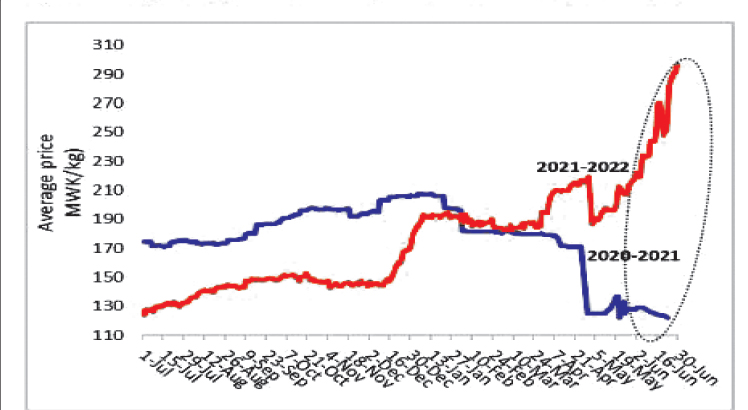Maize prices continue to rise on the local market, a development grain market traders and analysts have attributed to the growing demand for the staple grain amid dwindling supply.
Spot-checks by Business Review in some produce markets showed that a 50 kilogramme (kg) bag of maize is now selling at K18 500, up from K15 500 in July, according to the World Food Programme (WFP) Minimum Expenditure Basket published earlier this month.
International Food Policy Research Institute (Ifpri) data shows that during the same period last year, maize was selling at K 7 000 per 50 kg bag, which means that at the current K18 500, the commodity has risen by 164 percent between August 2021 to date.
Speaking in an interview on Tuesday, Grain Traders Association of Malawi president Grace Mijiga Mhango attributed the increase in maize prices to supply and demand forces, largely fuelled by the low production of the commodity and the recent 25 percent devaluation of the kwacha.
She said: “One underlying factor to the rising maize prices is that unlike previous years, maize has not moved from the local farmers in rural areas to peri-urban areas where there is usually demand for the commodity. Farmers, in view of news that production of maize is low this year, are hoarding the grain in anticipation of even higher prices.
“On the other hand, the [25 percent] devaluation of the kwacha has also created room for traders from Tanzania and neighbouring countries to opt for Malawi maize which has become cheaper in the process creating pressure on the local market. People are, therefore, scrambling for the few that is on the market, thereby driving up prices.”
Agriculture development policy analyst Tamani Nkhono-Mvula said the increase in maize prices is a reflection of the supply of the commodity on the market as well as speculation of the same.
He said: “We had a lot of challenges to do with production this year and this has led to a decrease in maize supply. Compared to last year, the supply is relatively low this year and this is a fact.
“On the other hand, with the low production of maize this year, people are taking advantage of this to hike prices. Regardless of this, the outlook does not look good because this is only August and the prices are this high. Going towards October, we see prices going as high as K25 000.”
Nkhono-Mvula has since urged the government to subsidise the prices of maize, saying if this is not done, most people will be food insecure this year.
In a separate interview, Consumers Association of Malawi executive director John Kapito said the rising maize prices have created challenges on consumers amid cost of living crisis.
Ministry of Agriculture crop estimates results show that Malawi was expected to realise a below-average harvest for essential food and cash crops where maize is expected to be below the five-year average of 13 percent.
It was estimated that 3.9 million metric tonnes (MT) of maize will be produced in the 2022/23 growing season down from 4.4 million MT last year.
Maize, as part of foods in the Consumer Price Index, a measure of price change in a basket of constant quantity and quality of goods and service, contributes about 52 percent to the inflation basket, which means a change in prices either way has a bearing on the cost of living.
The rising maize prices will, therefore, have a negative impact, especially on lower income households’ access to food and necessities as it would continue to push up inflation.
The post Maize demand drives up prices, say traders appeared first on The Nation Online.
 Moni Malawi
Moni Malawi 
